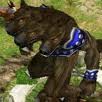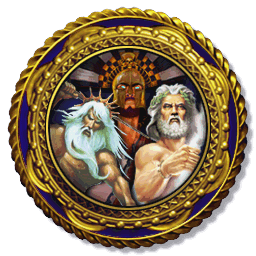| This article is about the civilization in Age of Mythology. For the civilization featured in Age of Empires, see Greeks (Age of Empires). |
The Greeks are a culture in Age of Mythology. They can be considered the default culture and are the first encountered in the game's campaign.
Gods
Major gods
Minor gods
Classical Age
Heroic Age
Mythic Age
Heroes
The Greeks have a different Hero for each major God and each Age. Unlike other heroes, they are strong against small numbers of human soldiers in addition to myth units, but they cannot be mass-produced.Template:Navbox Greek Heroes
Favor

Villagers praying at a Temple
The Greeks gather favor like other resources. Their villagers pray at Temples, and the more villagers praying there are, the faster the favor rate. This makes regulating favor simple but takes up population space that could be dedicated somewhere else.
Titan (The Titans)

Cerberus
The Greek Titan in the The Titans expansion is the three-headed dog Cerberus.
Units
The Greeks can be considered as having the most standardized and easily memorized military in the game. Each class of human units — infantry, archer, and cavalry — is produced and upgraded by its own class-specific building.
In the Classical Age, the Greeks can train the Hoplite, Toxotes, and Hippikon which are infantry, archer, and cavalry units that follow the game’s basic rock-paper-scissors model of unit advantage. These three units are more expensive than their Classical Egyptian and Norse counterparts, but are also stronger, meaning the Greeks have better units in the early game.
In the Heroic Age, hard counter units (Hypaspist, Peltast, and Prodromos) become available. Each of these units does low base damage but has a very large bonus against other units of its own class. For example, the Prodromos is a cavalry unit that has a very high damage multiplier versus other cavalry, and is much stronger against cavalry than the Hoplite. The Greeks are the only culture to have a ranged Heroic Age siege unit - the Petrobolos.
In the Mythic Age, the Greeks can train a unit unique to their major god. These special units cost more than regular units but are also stronger and have special characteristics. Worshippers of Zeus have Myrmidons, strong infantry units with a bonus attack against units of the other cultures. Worshippers of Hades gain Gastraphetes, long-range archers which deal crush damage, allowing them, en masse, to besiege enemy buildings. Worshippers of Poseidon have the Hetairoi, cavalry units that do additional damage to buildings. All Greek players can also train the Helepolis, a siege unit that can garrison five units within it and shoot bolts that deal high crush damage.
The Greeks possess some of the strongest myth units in the game but they are often expensive and can be hard to mass-produce without focusing an excessive amount of villagers on praying for favour.
Starting conditions
Each of Age of Mythology's five cultures has different starting conditions in a normal game. The Greeks start out with a Town Center, three villagers and a Kataskopos. The Kataskopos is a scout unit and is useful early on, though they can be replaced by Pegasi fairly quickly. Further Kastaskopi cannot be trained.
Other attributes
The Greeks are very versatile and play similarly to civilizations from Age of Empires II, so they are the easiest to start out with. Their military for example is created the same way. Infantry from a barracks, archers from an archery range, and cavalry from the stable. Greeks also possess the strongest heroes in the game but they cannot be mass-produced, with a maximum of four (five with Poseidon, who allows building a hero ship, The Argo).
In-game dialogue language
Where different, Ancient Greek transliteration is given in small letters.
- Ἕτοιμος/Ἑτοῖμος [hetoimos] (etimos) (m), ἑτοίμη [hetoimē] (etimi) (f) - ready/willing
- Πρόσταγμα; [prostagma] (prostaghma?) - Order/command?
- Λέγε [lege] (leye) - Speak or collect (archaic)
- Όρθῶς [orthōs] (orthos) - correctly
- Μάλιστα (malista) - of course/absolutely (lit. most)
- Ναί [nai] (ne) - yes
- Καλώς [kalōs] (kalos) - good, well
- Βούλομαι [boulomai] (vulome) - I will/I want
- Μεταλλεύς [metalleus] (metalefs) - metal worker
- Θηρευτής [thēreutēs] (thireftis) - hunter/predator
- Βουφορβός [bouphorbos] (vouforvos) - ox herder (when collecting berries)*
- Δρυτόμος [drytomos] (dhritomos) - timber, woodcutter (lit. oak cutter)
- Πάμε (pame!) - Let’s go!
- Πρόσεχε (prosekhe!) - Give me an order (lit. bring [me] somewhere)
- Εἰς μάχην [eis makhēn] (is makhin) - to battle
- Εἰσβολή [eisbolē] (isvoli) - invasion!
- Ἔστω [estō] (esto) - let it be / so be it
- Πανύ [pany] (pani) - very well (lit. much/ at a great degree)
- Πόρρω [porrō] (porro) - forward!
Notes
1) Apart from the accent being anachronistic (the letter υ was pronounced like the French u, certain modern sounds did not occur in Ancient Greek and vice versa), the language also featured pitch accent, not unlike certain European languages, like Swedish.
2) Βουφορβός is a wrong choice, as depending on the context, it means either ox herder or shepherd. A more correct word would be καρποσυλλέκτης (karposyllektēs), fruit collector.
AI player names
All Versions
Vanilla and the Extended Edition
These names only appear on AI players following the Big Boomer or the Aggressive Rusher AI.
Vanilla only
These names only appear on AI players following the Balanced or the Vanilla Random AI.
Trivia
- In the Alpha of Age of Mythology, the Greeks' architecture set originally was more historically accurate. The buildings all had whiter textures and bright red tile roofs, the human units were also more accurate to the Hellenic Era in which they are portrayed.
- The Greeks also had several additional units: the Griffon, Cataphract, War Turtle, Harpy, Oxybeles (a Greek Ballista), and Misenus, the original Campaign hero.
- The Greeks mainly draw influence from Hellenistic-era Greece, especially from the kingdom of Macedonia, attested from the presence of Helepoli, Hetairoi, Hypaspists, Prodromi, and the Sarissa upgrade. Triremes' sails also depict the Vergina Sun, also known as the Star of Vergina.
- However, they also draw their influence from Classical Greece, particularly Athens, as attested from some myth technologies (most notably Trierarch and Athenian Wall), and the presence of Hoplites and Toxotes.
- Two of their units are also influenced from non-Greek cultures; the Peltast unit is of Thracian origin, whereas the Toxotes are based on an Athenian police/safeguarding force, composed of Scythian slaves, armed with a "toxon" (τόξον: bow, a word of Indo-Iranian origin).
Template:Culture

